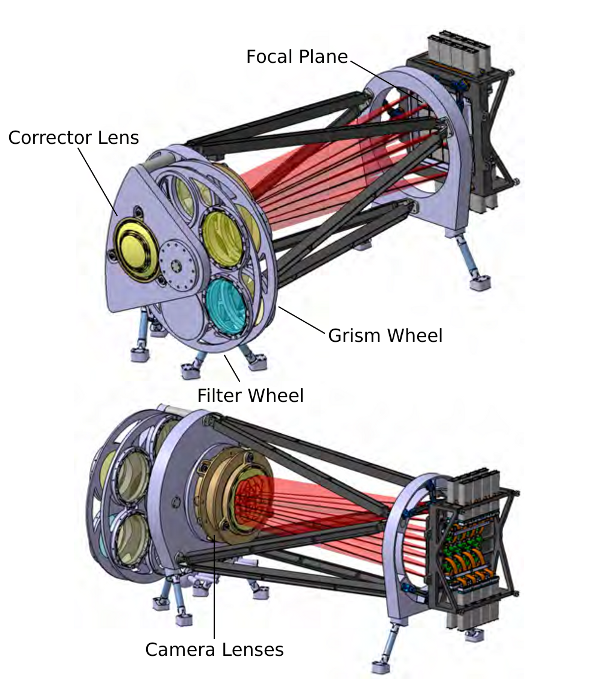The NISP Instrument
MPIA is involved in the development of the Euclid Mission's Near-Infrared Spectrometer and Photometer (NISP) instrument. The NISP Instrument has two channels: a near-infrared photometer (NISP-P) and a near-infrared slitless spectrometer (NISP-S). The baseline implementation of the NISP Instrument can be seen in picture below. The two channels have common optics, focal plane, electronics and support structure. Two wheel mechanisms are used to switch between the different channels: (1) a filter wheel mechanism contains the three near-infrared photometry filters, a cold shutter and an open position and (2) a grism wheel with four grisms and an open position. To operate in the photometric mode, the grism wheel is rotated to the open position and the filter wheel is rotated to the required filter; to operate in spectroscopic mode the filter wheel is rotated to the open position and the grism wheel to a grism position. The optics consist of a corrector lens at the start of the instrument and a three lens camera after the grism/filter position that focuses light onto the focal plane. The large focal plane is made up from a mosaic of 4 × 4 of Teledyne's Hawaii 2RG 2k × 2k near-infrared detectors.
The NISP Photometric Channel (NISP-P) will image the sky in three near-infrared bands: Y (0.920 - 1.146 μm), J (1.146-1.372 μm) and a long H (1.372 - 2.000 μm). The resulting dataset will have a point source detection limit (5σ) of 24 AB mag for over 90 % of the survey, a depth that would be very difficult to reach from the ground over such a large area of the sky. The channel has a large 0.55 deg2 field-of-view. With only 16 2k × 2k detectors, this results in a pixel scale of 0.3 arcsec and therefore the channel is undersampled. The channel is a photometer; not an imager.
The NISP Spectroscopic Channel (NISP-S) will perform slitless (R = 250) spectroscopy in two bands: filter coatings on the grism elements allow selection between the 1.10 - 1.45 μm and 1.45 - 2.00 μm wavelength ranges. The channel is a slitless spectrometer, so confusion between the spectra from different sources is a critical issue. To help distinguish between different sources, the channel includes two identical grism elements for each band. These are mounted with a 90 deg rotation between their lines, so that the spectrometer's dispersion direction can be changed to help distinguish overlapping spectra. The channel will be sensitive enough to detect (3.5σ) a 3 × 10-16 erg cm-2 s-1 line flux.
